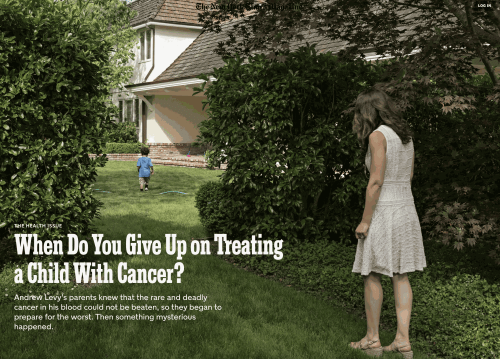Photographs by Lucas Foglia have been published in the New York Times following the touching story of cancer in children.
Article by MELANIE THERNSTROM
Extract below...
Andrew Levy’s parents knew that the rare and deadly cancer in his blood could not be beaten, so they began to prepare for the worst. Then something mysterious happened.
When Esther and Dan Levy’s son Andrew was 14 months old, he received a diagnosis of a kind of leukemia so rare that their medical team said getting it was like being bitten by a shark and struck by lightning at the same time.
Leukemia, a cancer of those cells in the bone marrow that produce new blood cells, has many varieties, but the most common type in children, acute lymphocytic leukemia, is largely curable. Andrew’s cancer, however, a subtype of acute megakaryoblastic leukemia (AMKL), affects only about 45 children a year nationwide and is much more difficult to treat. The odds of surviving this type of AMKL are roughly even — unless the child is one of a handful who happen to have a particular genotype, in which case these odds plummet to a mere one in 10. Genetic analysis revealed that Andrew was in this tiny group.
There was more bad news. Two weeks after the diagnosis, Andrew’s doctor, Norman Lacayo, an oncologist at Lucile Packard Children’s Hospital at Stanford University, received an urgent call from Michael Loken, the president of Hematologics Inc., a Seattle lab that was analyzing Andrew’s cells. Loken had recently discovered that a small percentage of children with AMKL had a specific phenotype — a pattern of proteins on the surface of the leukemia cell he called R.A.M. (a former patient’s initials) — that independently predicted a terrible outcome, with a survival rate of about one in six. Andrew had this phenotype too.

